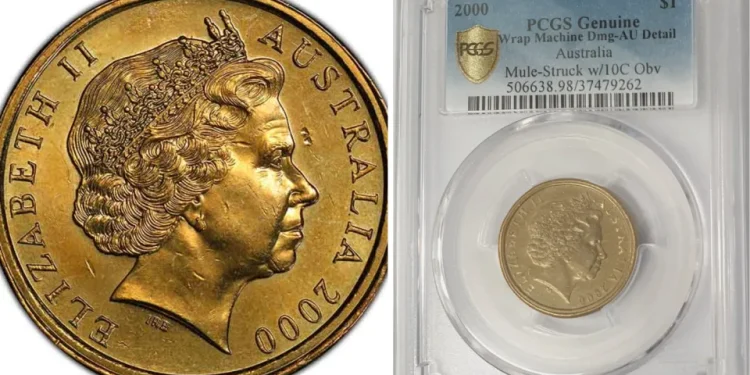The world of coin collecting is full of rare finds, and one of the most intriguing examples is the 2000 $1 mule coin. Struck by the Royal Australian Mint over two decades ago, this error coin has captivated collectors and investors alike. While most $1 coins follow the expected pattern, this one is special because of a rare minting mistake involving a mix-up with coin dies. This article delves into the history, value, and significance of the 2000 $1 mule coin.
What is a Mule Coin?
This Article Includes [hide]
In coin collecting, the term “mule” refers to a coin that is produced by the use of mismatched dies during the minting process. This results in a coin that has a combination of obverse and reverse sides that were not intended to be used together. The 2000 $1 mule coin is a perfect example of this error, where the reverse side of the coin was struck with the normal $1 die, but the obverse was struck with a 10-cent die, creating a distinct border that isn’t found on regular $1 coins.
The Discovery of the 2000 $1 Mule Coin
The 2000 $1 mule coin was discovered almost by accident, and it didn’t take long for collectors to notice the mistake. According to Mark Nemtsas of The Purple Penny, tens of thousands of these mule coins were struck, but their true value wasn’t immediately clear. As the error spread across the media, it became a collector’s dream to find one in their change. The hunt for the 2000 mule coin became an obsession for many, with people scouring their pockets, wallets, and even banknotes for a chance to strike gold.
Value of the 2000 $1 Mule Coin
The value of the 2000 $1 mule coin can vary significantly depending on its condition. Coins that are uncirculated or in excellent condition can fetch prices in the thousands. Some examples of these coins are listed online for as much as $6,500, although most of these are uncirculated specimens in near-perfect condition.
Mark Nemtsas explains that an uncirculated coin can command a price of a few thousand dollars. However, given the 24 years of circulation that most of these coins have endured, finding one in pristine condition is nearly impossible. In fact, while there were many mule coins struck, only about 20,000 are believed to exist today.
How to Spot a 2000 $1 Mule Coin?
Collectors should be cautious when purchasing a 2000 $1 mule coin, as counterfeit coins can be difficult to identify, especially when buying online from platforms like eBay. For this reason, it is advisable to seek out coins that have been authenticated by a reputable grading service, such as the Professional Coin Grading Service (PCGS). A PCGS rating provides a reliable measure of a coin’s authenticity and value, based on its condition, appearance, and rarity.
The PCGS grading system ranges from MS/PR70 (the highest grade, indicating a coin is flawless) to lower grades, like MS64, which signifies a coin that has scattered marks but is still considered a rare find. Only five of the 500 mule coins examined by PCGS were graded MS64 or higher, further contributing to the rarity and high value of these coins.
The Hunt for the 2000 $1 Mule Coin
In the early 2000s, the excitement surrounding the 2000 $1 mule coin led to a frenzy. Collectors lined up at banks to withdraw bags of $1 coins, while others visited stores and restaurants, swapping rolls of coins in search of the rare mule. Children even joined in, checking their change during lunch breaks at school. The chase to find one of these coins became a cultural phenomenon, with some collectors even spending years searching for the elusive mule.
One diligent Perth collector was able to find 180 examples of the 2000 $1 mule coin over the course of two years, combing through the coin bins of poker machines. Despite the widespread search, finding an uncirculated coin remains a rare feat.
Conclusion: A Modern Classic in Coin Collecting
More than two decades after its discovery, the 2000 $1 mule coin remains a prized possession for collectors. Its accidental creation has ensured its place in Australian numismatic history, with its rarity and distinct error continuing to capture the attention of enthusiasts. While these coins can be worth hundreds or even thousands of dollars, it’s important for collectors to exercise caution when purchasing them. For those who can find an authenticated specimen in good condition, the 2000 $1 mule coin stands as a testament to the unexpected beauty that can arise from minting errors.
Also Read:
- Trader Turns $1.1K Investment into $1.62 Million in 20 Days with Meme Coins
- Biden Commits Historic $4 Billion to World Bank Fund Supporting Poorest Nations


